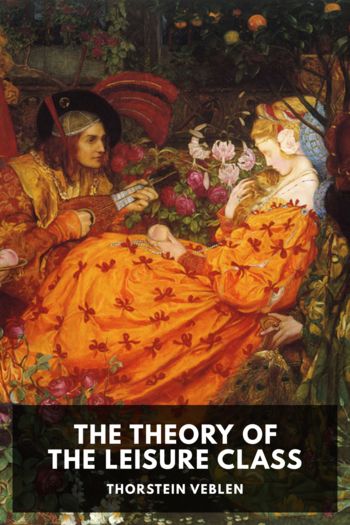The Theory of the Leisure Class by Thorstein Veblen (phonics readers TXT) 📕

- Author: Thorstein Veblen
Book online «The Theory of the Leisure Class by Thorstein Veblen (phonics readers TXT) 📕». Author Thorstein Veblen
The priest should not put his hand to mechanically productive work; but he should consume in large measure. But even as regards his consumption it is to be noted that it should take such forms as do not obviously conduce to his own comfort or fullness of life; it should conform to the rules governing vicarious consumption, as explained under that head in an earlier chapter. It is not ordinarily in good form for the priestly class to appear well fed or in hilarious spirits. Indeed, in many of the more elaborate cults the injunction against other than vicarious consumption by this class frequently goes so far as to enjoin mortification of the flesh. And even in those modern denominations which have been organized under the latest formulations of the creed, in a modern industrial community, it is felt that all levity and avowed zest in the enjoyment of the good things of this world is alien to the true clerical decorum. Whatever suggests that these servants of an invisible master are living a life, not of devotion to their master’s good fame, but of application to their own ends, jars harshly on our sensibilities as something fundamentally and eternally wrong. They are a servant class, although, being servants of a very exalted master, they rank high in the social scale by virtue of this borrowed light. Their consumption is vicarious consumption; and since, in the advanced cults, their master has no need of material gain, their occupation is vicarious leisure in the full sense. “Whether therefore ye eat, or drink, or whatsoever ye do, do all to the glory of God.” It may be added that so far as the laity is assimilated to the priesthood in the respect that they are conceived to be servants of the divinity. So far this imputed vicarious character attaches also to the layman’s life. The range of application of this corollary is somewhat wide. It applies especially to such movements for the reform or rehabilitation of the religious life as are of an austere, pietistic, ascetic cast—where the human subject is conceived to hold his life by a direct servile tenure from his spiritual sovereign. That is to say, where the institution of the priesthood lapses, or where there is an exceptionally lively sense of the immediate and masterful presence of the divinity in the affairs of life, there the layman is conceived to stand in an immediate servile relation to the divinity, and his life is construed to be a performance of vicarious leisure directed to the enhancement of his master’s repute. In such cases of reversion there is a return to the unmediated relation of subservience, as the dominant fact of the devout attitude. The emphasis is thereby thrown on austere and discomforting vicarious leisure, to the neglect of conspicuous consumption as a means of grace.
A doubt will present itself as to the full legitimacy of this characterization of the sacerdotal scheme of life, on the ground that a considerable proportion of the modern priesthood departs from the scheme in many details. The scheme does not hold good for the clergy of those denominations which have in some measure diverged from the old established schedule of beliefs or observances. These take thought, at least ostensibly or permissively, for the temporal welfare of the laity, as well as for their own. Their manner of life, not only in the privacy of their own household, but often even before the public, does not differ in an extreme degree from that of secular-minded persons, either in its ostensible austerity or in the archaism of its apparatus. This is truest for those denominations that have wandered the farthest. To this objection it is to be said that we have here to do not with a discrepancy in the theory of sacerdotal life, but with an imperfect conformity to the scheme on the part of this body of clergy. They are but a partial and imperfect representative of the priesthood, and must not be taken as exhibiting the sacerdotal scheme of life in an authentic and competent manner. The clergy of the sects and denominations might be characterized as a half-caste priesthood, or a priesthood in process of becoming or of reconstitution. Such a priesthood may be expected to show the characteristics of the sacerdotal office only as blended and obscured with alien motives and traditions, due to the disturbing presence of other





Comments (0)